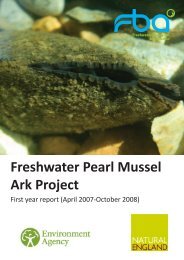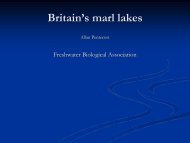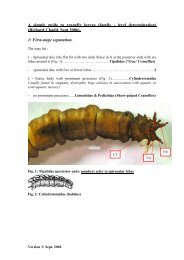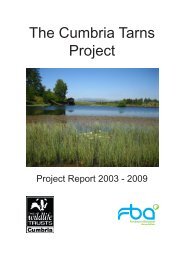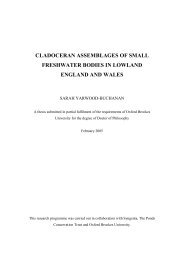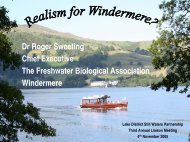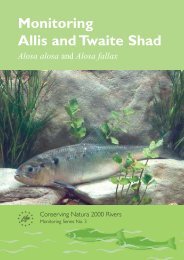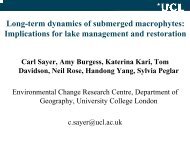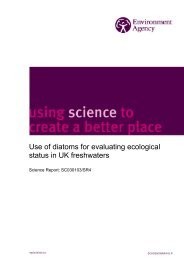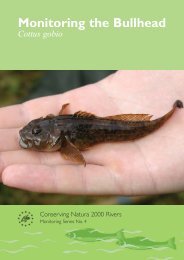Groundwater HIA post edit - FreshwaterLife
Groundwater HIA post edit - FreshwaterLife
Groundwater HIA post edit - FreshwaterLife
You also want an ePaper? Increase the reach of your titles
YUMPU automatically turns print PDFs into web optimized ePapers that Google loves.
i. Establish a preliminary conceptual model of the river-aquifer system, and<br />
choose whichever analytical solution available in IGARF is closest to the<br />
conceptual model.<br />
ii. Using IGARF, make initial predictions of the likely impacts of the<br />
abstraction, carrying out sensitivity analysis on the input parameters to give<br />
a range of likely impacts.<br />
iii. Design a field pumping test based on the predictions, using IGARF to<br />
indicate whether these changes are large enough to be observed, and if so,<br />
over what time-period monitoring should be maintained, and how far<br />
upstream and downstream the river flow should be monitored.<br />
iv. Conduct the pumping test, analyse and interpret the results to evaluate<br />
impacts on the river and to calculate aquifer physical properties.<br />
v. Review the conceptual model, the selection of analytical solution and the<br />
range of parameter values used in IGARF.<br />
vi. Make predictions of the long-term impacts, using IGARF as a guide, and<br />
taking into account all uncertainties.<br />
3.3.3 Tier 3 tools<br />
The main tools likely to be used at the level of Tier 3 are spatially-distributed, timevariant<br />
and usually three-dimensional numerical groundwater models, calibrated and<br />
validated against historical data. Such models should only be used by experienced<br />
hydrogeologists and groundwater modellers, as their use is by no means intuitive. The<br />
main modelling codes likely to be used are:<br />
• MODFLOW: a freely available code developed by the United States<br />
Geological Survey, which has become the industry standard. Many pre-<br />
and <strong>post</strong>-processors and other useful software modules have been<br />
developed for MODFLOW.<br />
• ZOOMQ3D: a relatively new code being developed jointly by the University<br />
of Birmingham, the Environment Agency, and the British Geological<br />
Survey.<br />
• MIKE-SHE: a package of models and graphical user interface developed<br />
and marketed by DHI Water and Environment, Denmark.<br />
• FEFLOW: a finite-element model (the other three are finite-difference<br />
models) developed by WASY GmBH, Germany.<br />
The Environment Agency's current preferred numerical groundwater modelling<br />
software is MODFLOW, with <strong>Groundwater</strong> Vistas as the user interface.<br />
3.3.4 Other useful techniques<br />
Many other investigative techniques may be useful when undertaking <strong>HIA</strong> at any level.<br />
If considered appropriate, and used carefully, these techniques can provide additional<br />
information that may help with the development of conceptual models, and the<br />
prediction of impacts. Such techniques include the following:<br />
• Tracer tests: which involve adding a suitable tracer (such as a fluorescent<br />
dye) to groundwater, with the aim of establishing a flow connection<br />
18 Science Report – Hydrogeological impact appraisal for groundwater abstractions




